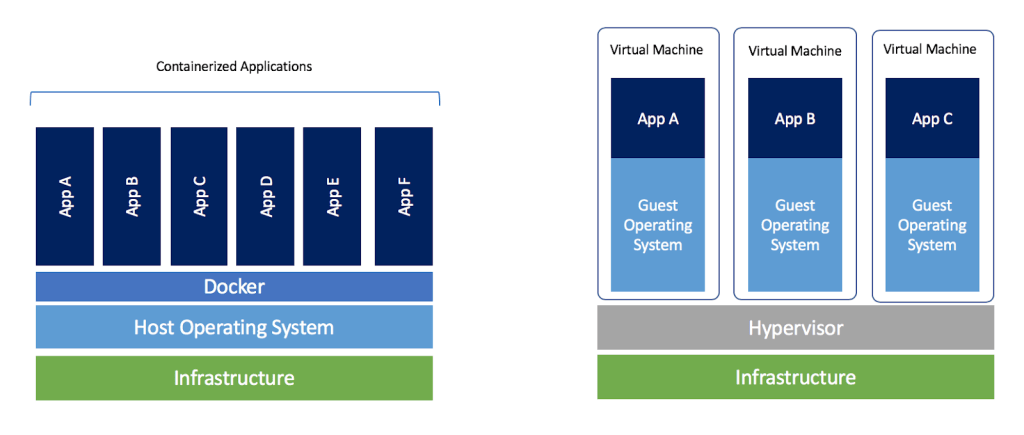การใช้งาน Vagrant
vagrant คืออะไร ? และวิธีการใช้อย่างง่าย
เปรียบเทียบกับ docker
Docker Docker จะทำการสร้าง Environment เพื่อ run application นั้นๆ ซึ่งเรียกว่า Container เป็นการทำงานลักษณะแบบ Virtual Environment (VE) คือ ไม่สามารถติดตั้ง OS แยกกันได้ อาศัย ทรัพย์กรจากเครื่องที่ตั้ง Envoriment ที่มี
Vagrant เป็นการเขียน script เพื่อ สร้าง การทำงานในลักษณะ Virtual Machine (VM)
การทำงานในลักษณะ Virtual Environment (VE) แตกต่างกับ Virtual Machine (VM) ตรงที่จะไม่มีการจอง CPU, Memory, Disk ดังภาพ

เตรียมความพร้อมก่อนเริ่มใช้งาน
- Virtualbox #Vagrant 6.0
Download_Old_Builds_6_0 – Oracle VM VirtualBox
- Vagrant #Vagrant 2.2.6
Download - Vagrant by HashiCorp
Install Vagrant
- MacOS
$ brew cask install vagrant
*** ในตอนนี้ vagrant 2.2.6 รองรับ virtualbox ไม่เกิน version 6.0
How to start
- Step 1
$ mkdir vagrant-example && cd vagrant-example
- Step 2
# เป็นการ initail เพื่อให้ได้ vagrantfile
$ vagrant init
# or
$ vagrant init centos-7
# เพื่อเป็นการ init ตัว os ที่เราต้องการจะสร้าง
ภายใน VagrantFile
Vagrant.configure("2") do |config|
config.vm.box = "centos/7"
end
- Step 3 จำลอง ด้วยการ install Nginx ภายใน
Vagrant.configure("2") do |config|
config.vm.box = "centos-7"
config.vm.network "forwarded_port", guest: 80, host: 8080, id: "nginx" # เป็นการ forward port ภายในออกนอก
config.vm.provision "shell", inline: <<-SHELL
sudo yum install epel-release -y
sudo yum update -y
sudo yum install nginx -y
sudo systemctl start nginx
SHELL
end
- step 4
$ vagrant up
ทั้งนี้ยังสามารถสร้างใน provider เช่น DigitalOcean , Aws , ….
- List Command
$ vagrant box # manages boxes: installation, removal, etc.
$ vagrant destroy # stops and deletes all traces of the vagrant machine
$ vagrant global-status # outputs status Vagrant environments for this user
$ vagrant halt # stops the vagrant machine or Shutdown
$ vagrant help # shows the help for a subcommand
$ vagrant init # initializes a new Vagrant environment by creating a Vagrantfile
$ vagrant login #log in to HashiCorp’s Atlas
$ vagrant package #packages a running vagrant environment into a box
$ vagrant plugin # manages plugins: install, uninstall, update, etc.
$ vagrant port # displays information about guest port mappings
$ vagrant powershell # connects to machine via powershell remoting
$ vagrant provision # provisions the vagrant machine
$ vagrant push #deploys code in this environment to a configured destination
$ vagrant rdp # connects to machine via RDP
$ vagrant reload # restarts vagrant machine, loads new Vagrantfile configuration
$ vagrant resume # resume a suspended vagrant machine
$ vagrant snapshot # manages snapshots: saving, restoring, etc.
$ vagrant ssh # connects to machine via SSH
$ vagrant ssh-config # outputs OpenSSH valid configuration to connect to the machine
$ vagrant status # outputs status of the vagrant machine
$ vagrant suspend # suspends the machine
$ vagrant up # starts and provisions the vagrant environment
$ vagrant version # prints current and latest Vagrant version